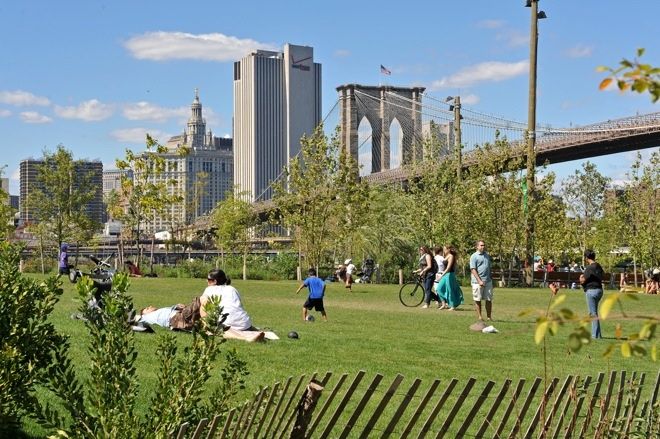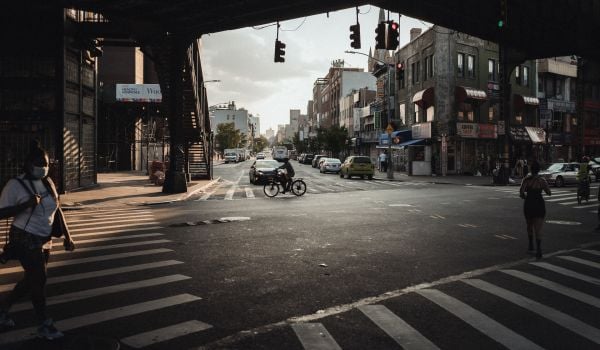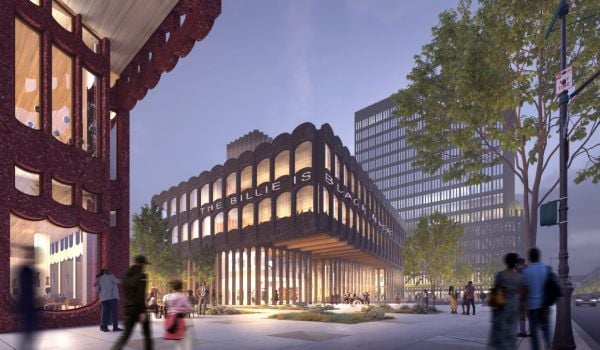Editor’s note: This is the first in a series of interviews by Mary Jones with the 2011 winners of the Rudy Bruner Award. Brooklyn Bridge Park was one of four Silver Medalists. For more information on the Rudy Bruner Award please visit http://www.brunerfoundation.org/rba/.
The Brooklyn Bridge Park had been in the works for nearly 20 years. What finally made this vision a reality?
Brooklyn Bridge Park has been a community goal since the first glimmer of an idea in the mid-1980s when the Port Authority property ceased its shipping operations on the site. Today’s park is the result of dedicated advocacy and planning by community members, elected officials and civic organizations. A major turning point in the park’s development is the 2002 Memorandum of Understanding which created the park, signed by New York City Mayor Bloomberg and New York State Governor George Pataki. This 2002 agreement facilitated the first dedication of capital funds and marked the beginning of a productive era that saw the engagement of Michael Van Valkenburgh Associates as the landscape architect for the project and the establishment of an entity charged with building, operating and maintaining the new sustainable civic amenity. Now, over 20 acres are open with more sections coming on-line this year and next. Momentum is strong and the response by the public has been overwhelming.
Why was building a park on Brooklyn’s waterfront so important?
Brooklyn has historically been an under-served borough when it comes to open space recreation. The residential neighborhoods surrounding the planned park have experienced tremendous growth over the last two decades, putting a strain on existing parks in the area. When the opportunity was presented for adaptive re-use of the piers and their uplands, a park was a natural choice, offering this ascendant Borough a new front yard and linkage with the great amenities being developed around the harbor including Governors Island, East River Waterfront park and Hudson River Park, as well as the 15-mile Brooklyn Greenway which encompasses the site. This newly opened public realm offers a tremendous window on the majesty of the New York Harbor and allows visitors to experience the enormity of the harbor from a space that is both intimate and grand, depending on your placement in the park.
The park has only been open a year. What has been its immediate impact on the surrounding community?
The park transformed a once-vacant and inaccessible stretch of Brooklyn’s waterfront into a vibrant public space in a very short time. Thousands of visitors have made Brooklyn Bridge Park their seasonal destination, adopting our greenway as their running, jogging, biking and dog walking route, seeing movies and concerts with the Lower Manhattan skyline as the backdrop, bringing their children to play at the inventive and diverse play environments, or trying a kayak for the first time and experiencing the city from an entirely new vantage point. The unique opportunities that Brooklyn Bridge Park offers continues to diversify and further embed this new amenity into the lives, hearts and souls of residents and visitors.
The communities surrounding the park are likewise being revitalized by this wonderful public amenity. The Columbia Street Waterfront District, an emergent neighborhood south of Pier 6, has seen increased residential sales since the park’s opening. Commercial businesses along Atlantic Avenue are also experiencing growth. The popularity of Pier 1 has helped to secure commercial business along Old Fulton Street.
The park will directly add jobs and commercial activity predominantly through its development sites. In addition to residential developments with ground floor retail, the park plan calls for a hotel on Pier 1 and the adaptive re-use and renovation of Empire Stores into a retail and commercial complex. An increasing number of concessions will do business in the park this season, from bike rentals to burritos.
What can other cities learn from this park when redeveloping areas for city parks?
Brooklyn Bridge Park is a trailblazing park in a number of ways. The park’s mandate to be fiscally self-sustaining, its environmental sustainability measures, its connectivity, its responsiveness to community articulated goals and the unique collaboration between City and State government all set it apart from traditional park projects. These elements define large public investments in the 21st century. Brooklyn Bridge Park’s experience will provide a blueprint for the redevelopment of post-industrial waterfront projects. The park project, combined with New York City’s comprehensive waterfront vision, is a model for transforming underutilized urban waterfronts into productive and desirable new uses, and ensuring their upkeep for the next generation of park visitors.
















